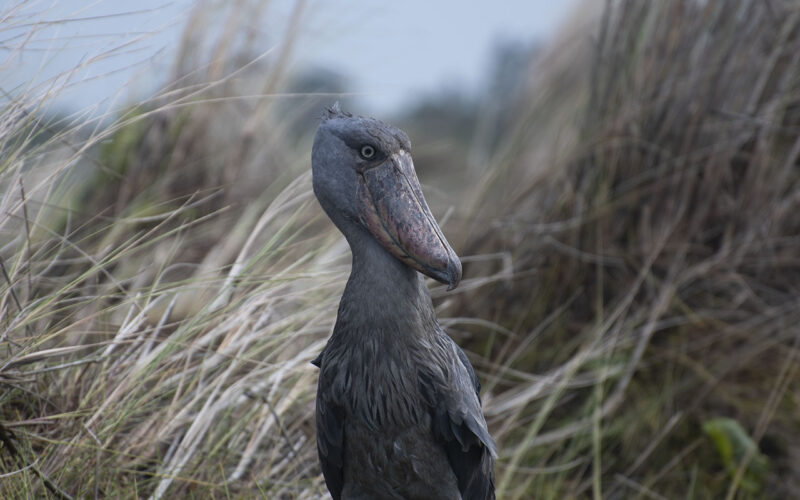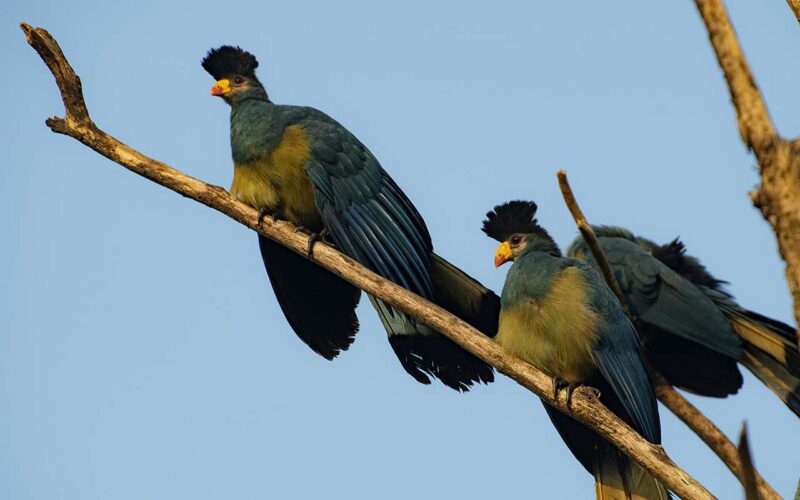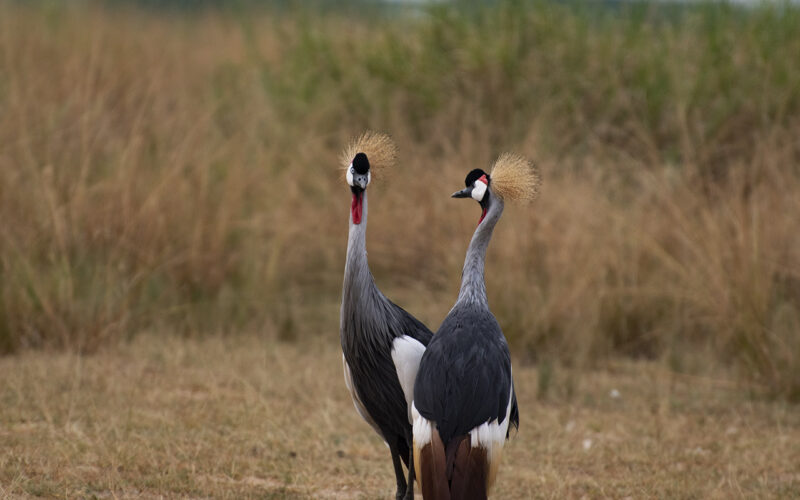Uganda is Africa’s top birding destination with an impressive checklist of over 1080 bird species from its plethora of habitats, almost equivalent to 50% of the continent’s bird list. Located at the heart of Africa, Uganda geographically lies at confluence of Africa’s 5 important bird biomes where the West African rainforests meet the East African savanna grasslands. These bird-rich habitats include extensive wetlands surrounding numerous freshwater lakes and rivers, montane rainforests in the Albertine Rift, semi-arid scrubland and bushlands, savanna grasslands and woodlands. This diversity of unique habitats hosts a variety of species from local to regional endemics, habitat restricted specialists, altitude-limited species and generalists.
Are you planning a Uganda birding tour soon, here is our Top 20 Birds to see on tour listed below following no particular criteria but purely from the feedback of our seasoned birding clients coming on our birding tours.
Top 20 Birds to see on a Uganda Birding Tour

The Shoebill
On top of the bird-list to see on a Uganda birding tour is undoubtedly the odd-looking Shoebill. The Shoebill (Balanaeniceps rex) is prehistoric, classified in its own class having no near affinities. A resident resident of marsh and secluded wetlands, the Shoebill is plumaged in uniform grey, standing at about 1.5m tall with an oversized straw-colored shoe-like bill from which it derives its name. Although rare and only known from a handful locations across Africa, in Uganda the Shoebill is encountered in the extensive wetlands of Mabamba set along the northern shores of Lake Victoria, the Nile Delta and in Ziwa Rhino Sanctuary.
Grauer’s (African Green) Broadbill
Next on the must-see birds on a Uganda birding tour is the Grauer’s Broadbill, a plump, leaf-green and short tailed flycatcher-like endemic to Albertine Rift and only known from about 2000 m asl within the primary rainforest belt in the Bwindi Impenetrable National Park. In this UNESCO world heritage site, the Grauer’s Broadbill prefers the canopies especially near the streams. For sometime, pairs of this little-known species have been monitored and now confirmed to breed successfully in this high-altitude section of Bwindi Impenetrable Forest.
Green-breasted Pitta
The Green-breasted Pitta is another gem to see on our birding tours where its is only known from mid-altitude forests of Kibale National Park. Very elusive and shy, the Green -breasted Pitta is a forest floor specialist but easily seen during breeding season where males put on characterful displays and calls to advertise territories and attract females.
Fox’s Weaver
The Fox’s weaver is Uganda’s endemic occurring in the flood grassland plains near Lake Bisinia and other areas within Teso region in eastern Uganda. Usually favoring water edge acacia trees, the species extends into Pian Upe reserve close to Mt Elgon NP which indicates its bigger range.
Karamoja Apalis
The Karamoja Apalis is the second Uganda endemic, a specialist of dry-thorn bush and scrub, in the far east of Uganda. Here its fond of Acacia drepanolobium where flocks can be seen gleaning for insects and more.
Rwenzori Turaco
Indeed the most colorfully painted turaco, the Rwenzori Turaco is an Albertine Endemic mainly favoring the montane slopes of Rwenzori mountain ranges and Mgahinga Gorilla NP.

Great Blue Turaco
Locally known as “tree-branch marathon runner” the Great Blue Turaco is characterful long-black crested blue turaco are often seen running, and jumping along large tree branches along and close to the forest edges even in mature gardens with large trees in urban centers.
Standard-winged Nightjar
The unique characterful nightjar puts on impressive wing shafts in males during breeding season (Sept-Apr) that literary look like small flags attached to the body by small wires.
Shelley’s Crimson Wing
This impressive Albertine endemic occurs in the mountain rainforests of Mgahinga and Bwindi Impenetrable NP. The largest of the crimson wings, its all red bill and yellow green throat and upper breast further separates it from the Red-faced and Dusky Crimson-wings that occur in the same range.
Neumann’s Warbler
With no known relatives, Neumann’s Warbler is an Albertine rift endemic occurring in the dense forest undergrowth near streams where it forages. It’s diagnostic long white-superciliary stripe recalls a Green Hylia but that species is not only larger and long tailed favoring mid-strata and forest canopy.
Bar-tailed Trogon
The colorful trogon replaces its savanna woodland cousin Narina Trogon in the highland and montane forests. Overall plumage is darker with black and white barred on the undertail, could be under looked when not calling regardless of its bright colors. The species is usually encountered in Bwindi and tropical forests on lower elevation on the Rwenzori mountain.
Papyrus Gonolek
The shy and golden-crowned Papyrus Gonolek is a Lake Victoria biome specialist occurring in papyrus swamps around Lake Victoria extending all the way to the western region and along the Nile Delta near Lake Albert.
African Finfoot
The African Finfoot is a secretive species usually encountered on backwaters of several water bodies and forest pools across selected birding sites within Uganda. The quiet waters of Lake Mburo NP is the most reliable site to tick off this rather shy species.
Grauer’s Swamp Warbler
Formerly named Grauer’s Rush Warbler, this critically endangered Albertine rift endemic is restricted to highland swamps above 2000m in the south-west, thou populations are dwindling due to habit conversion to agriculture in most of its range outside protected areas.
Kivu Ground Thrush
This shy and retiring forest thrush is restricted to the mountain rain forests in the Albertine rift area especially in Bwindi NP and Mgahinga Gorilla NP where pairs are usually encountered along the moist trails. Often treated as a race of the widespread Abyssinian Ground Thrush, the Kivu Ground Thrush (Geokichla.p.tanganjicae) differs in being brighter with entirely orange-brown crown and nape from mid-altitudes forest forms.
Handsome Spurfowl
Handsome indeed…it occurs in highland forests of Bwindi and Mgahinga Gorilla NP close and along the bamboo zones. Encountered in pairs, the Handsome Spurfowl is distinctive with bright red skin around the eyes separating them from the smaller Scaly Spurfowl that shares the same habitats.

Grey Crowned Crane
The graceful Grey Crowned Crane is Uganda’s national Bird, where it’s black, yellow and red plumage is our national flag colors. The country’s national soccer team; the Uganda Cranes is named after these attractive beautiful bird species. The species occur in small family flocks preferring inundated wetlands and moist agricultural habitats.
Black-breasted Barbet
A large barbet of mature woodlands, the Black-breasted Barbet is occasionally twitched near Murchison Falls NP, where it favors fruiting fig trees. Similar looking Double-toothed barbet has a bright red breast and throat.
Regal Sunbird
Endemic to the Albertine Rift, the Regal Sunbird is one common specie in the montane highlands Bwindi and Mgahinga NP. Colorful males are iridescent green above and throat, bright red on belly edged with broad yellow patches while female is uniform olive.
Final Word
The above list, impressive as it is represents a minute fraction of Uganda’s most attractive birds encountered on various tailor-made birding tours crafted to suit our clients expereince, expectations and comfort. Planning a birding trip to Uganda soon? Check out our detailed blog here.
